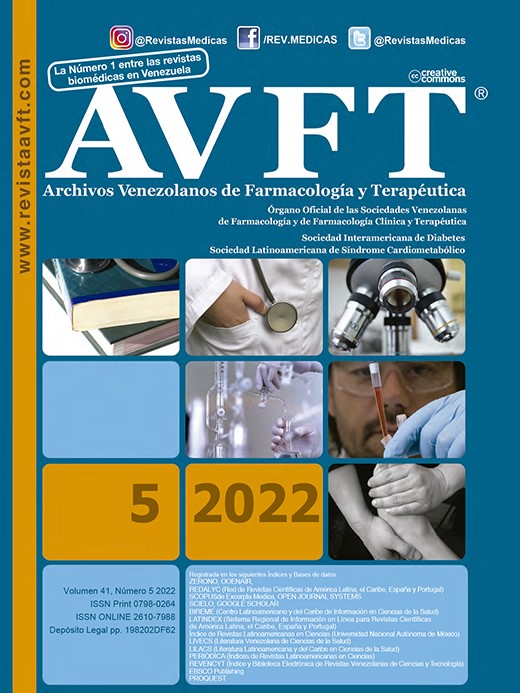Comportamiento de los hábitos alimenticios en los estudiantes de una institución educativa de Barranquilla-Colombia
Palabras clave:
Nutrición; Salud; Hábitos alimentarios; EstudiantesResumen
Introducción: Los hábitos alimenticios impactan notablemente en la salud del ser humano, de ahí la importancia de conocerlos con el fin de identificar factores de riesgos que pueden desencadenar enfermedades relacionadas con una nutrición inadecuada. Objetivo: identificar el comportamiento de los hábitos alimenticios en estudiantes de una institución educativa de Barranquilla-Colombia. Métodos: estudio cuantitativo, descriptivo y de corte transversal. La muestra correspondió a 426 estudiantes de una institución educativa con un promedio de edad de 14-16 años. El consumo de alimentos se determinó mediante un cuestionario estructurado y autoadministrado en el que se analizaron los hábitos alimentarios. Resultados: el 55% de los participantes fueron de sexo femenino, y masculino 45%. La mayoría pertenece a los estratos socioeconómicos 1 y 2. En relación a los hábitos alimenticios, los resultados del estudio mostraron que son inadecuados principalmente en relación a la frecuencia en su consumo y agregados insanos. Los estudiantes respondieron que siempre ingieren desayuno, nunca han llevado lonchera a la escuela, consumen comida salada y alta en grasa por lo menos una vez por día. El consumo de frutas y verduras lo realizan con poca frecuencia. Conclusión: Los hábitos alimenticios adecuados representan en edades tempranas un buen comienzo para el desarrollo de la persona y su devenir en cuanto a su salud. En la población estudiada, existe un inadecuado comportamiento de hábitos alimentarios por el acceso a los mismos debido a sus costos, así como evidencia de necesidad de educación hacia alternativas más saludables.
Descargas
Citas
Castillo V., Escalona J., Rodríguez C. Hábitos alimentarios en la población escolar chilena: Análisis comparativo por tipo de establecimiento educacional. Rev. Chil. Nutr. 2016 marzo; 43(1):06-11. Disponible en: http://dx.doi.org/10.4067/S0717-75182016000100001
Mundial de Organización Salud (OMS), Dieta, Nutrición y Prevención de Enfermedades Crónicas. Disponible en: http://www.fao.org/3/ac911s/ac911s00.pdf
Encuesta Nacional de la Situación Nutricional en Colombia 2010, Disponible en: https://www.minsalud.gov.co/sites/rid/Lists/BibliotecaDigital/RIDE/VS/ED/GCFI/Base%20de%20datos%20ENSIN%20-%20Protocolo%20Ensin%202010.pdf
Barragán L., Alarcón A. Estilos de vida saludables en personal docente, administrativo y de apoyo de la escuela de enfermería de la Universidad de Guayaquil 2015.Repositorio uniguayaquil. 2015. Disponible en: http://repositorio.ug.edu.ec/bitstream/redug/8196/1/PROYECTO%20DE%20INVESTIGACI%C3%93N%20ESTILOS%20DE%20VIDA%20SALUDABLES.pdf
Cigarroa I., Sarqui C., Zapata Lamana R., Efectos del sedentarismo y obesidad en el desarrollo psicomotor en niños y niñas: Una revisión de la actualidad latinoamericana. Rev Univ. Salud. 2016; 18(1):156-169. Disponible en: https://www.researchgate.net/profile/Igor_Cigarroa/publication/309601231_Efectos_del_sedentarismo_y_obesidad_en_el_desarrollo_psicomotor_en_ninos_y_ninas_Una_revision_de_la_actualidad_latinoamericana/links/5840544f08ae61f75dcee10b.pdf
Ministerio de Salud y Protección Social. Colombia (ENSIN) 2015.2015. Disponible en. https://www.minsalud.gov.co/Paginas/Barranquilla-recibio-resultados-de-Encuesta-Nacional-de-Situacion-Nutricional-de-Colombia-ENSIN-2015.aspx
Instrumento STEPS, El método STEPwise de la OMS para la vigilancia de los factores de riesgo de las enfermedades crónicas Organización Mundial de la Salud Avenue Appia, 1211 Geneva 27, Switzerland. Disponible en: www.who.int/chp/steps
Ministerio de Salud. Resolución número 008430 de 1993. Disponible en: https://www.minsalud.gov.co/sites/rid/Lists/BibliotecaDigital/RIDE/DE/DIJ/RESOLUCION-8430-DE-1993.PDF
Roberth Olmedo R, Domínguez J, Macías A. Hábitos alimenticios en estudiantes de la carrera de enfermería. Rev. de Salud VIVE.2019; 2(5): 92-98. Disponible en: http://revistavive.org/index.php/revistavive/article/view/29/116
Campo L, Herazo Y, García F, Suarez M, Méndez O, Vázquez F. Estilos de vida Saludables de niños, niñas y adolescentes. Rev. Científica Salud Uninorte. 2017; 33(3):419-428. Disponible en: http://rcientificas.uninorte.edu.co/index.php/salud/article/viewArticle/8767/214421442428
Duarte C. Factores relacionados con las prácticas alimentarias de estudiantes de tres universidades de Bogotá. Revista de Salud Pública 2015; 17(6). DOI: http://dx.doi.org/10.15446/rsap.v17n6.38368
Aulestia-Guerrero E, Capa-MoraU E. Una mirada hacia la inseguridad alimentaria sudamericana. Ciênc. saúde coletiva. 2020. 25(7). DOI: https://doi.org/10.1590/1413-81232020257.27622018
Sánchez Bizama J, Oda-Montecinos C, Cova Solar F, Hemmelmann Fuentes K, Betancourt Peters I, Beyle Sandoval C. Estilos de ingesta de estudiantes universitarios chilenos: ¿qué hay de nuevo? Nutr Hosp 2020;37(4):807-813. DOI: http://dx.doi.org/10.20960/nh.02656
Morales R., Lastre G., Vásquez A. Estilos de vida relacionados con factores de riesgo cardiovascular. Repositorio Universidad Simón Bolívar .2018; 2018 37(2)12-16 Disponible en:http://www.revistaavft.com/images/revistas/2018/avft_2_2018/11_estilos_de_vida_relacionados.pdf
Ceriani- Infantozzi F,De León- Giordano C. Características que se asocian con la omisión del desayuno en adolescentes montevideanos que concurren a colegios privados. Rev. Enfermería: cuidados humanizados. 2017; 6(2): 4-19.DOI: http://dx.doi.org/10.22235/ech.v6i2.1461.
Tuero, C. C., Zagalaz, J. C., Sánchez, M. L. Z., & de Mesa, C. G. G. Conocimientos e intereses sobre hábitos alimentarios saludables y práctica de actividad física. Un estudio con población adolescente. Aula abierta.2018. 47(2), 211-220.Disponible en: 10.17811/rifie.47.2.2018.211-220
Ávila M., Gutiérrez G., Martínez L., Ruíz J., Guerra J., Comportamiento e hábitos alimentares en alumnos do ensino básico. Horiz. Sanitario. 2018; 17(3): 217-225. Disponible en: http://dx.doi.org/10.19136/hs.a17n3.2113.
Muñiz-Mendoza P, Cabrera-Pivaral C, Orozco-Valerio M, Báez-Báez L, Méndez-Magaña A. Hábitos e ingesta alimentaria de frutas y verduras en estudiantes de educación superior. Rev. Chil. Nutr. 2018; 45(3): 258-262. DOI: http://dx.doi.org/10.4067/s0717-75182018000400258
Vera V, Crovetto M, Valladares M, Oñate G, Fernández M, Espinoza V, Mena F, Durán S. Consumo de frutas, verduras y legumbres en universitarios chilenos. Rev. Chil. Nutr. 2019; 46(4): 436-442. DOI: http://dx.doi.org/10.4067/S0717-75182019000400436.
Pampillo T., Arteche N., Méndez M., Hábitos alimentarios, obesidad y sobrepeso en adolescentes de un centro escolar mixto. Rev. Ciencias Médicas. 2019; 23(1): 99-107. Disponible en: http://scielo.sld.cu/scielo.php?script=sci_arttext&pid=S1561-31942019000100099&lng=es.
OMS. Obesidad Infantil: preguntas frecuentes. 2017. Disponible en:https://www.who.int/end-childhood-obesity/faq/es/
Tamames S. Implicaciones sociales y sanitarias de la obesidad mórbida. Rev. An RANM. 2019; 136 (02): 108 a 112. DOI: 10.32440/ar.2019.136.02.rev03
Médicos y pacientes. 2020. Disponible en: http://www.medicosypacientes.com/articulo/la-oms-avisa-de-que-el-consumo-de-grasas-trans-provoca-unas-500000-muertes-al-ano-en-todo
Descargas
Publicado
Cómo citar
Número
Sección
Licencia
Derechos de autor 2023 AVFT – Archivos Venezolanos de Farmacología y Terapéutica

Esta obra está bajo una licencia internacional Creative Commons Atribución-NoComercial-SinDerivadas 4.0.




